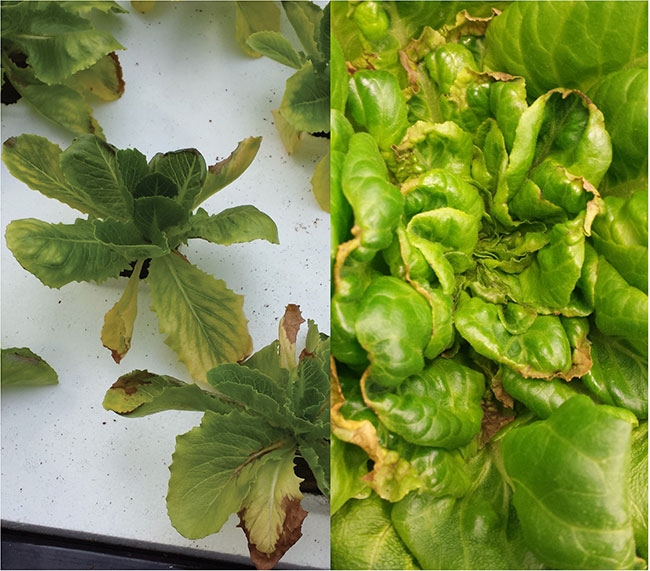
Features
Fertilizer
Inputs
Getting to the root of lettuce tip burn
August 6, 2019 By Greta Chiu
 Lettuce tip burn often lumps together two different physiological disorders: outer leaf edge burn (left) and inner leaf tip burn (right). IMAGES: M. Mirza
Lettuce tip burn often lumps together two different physiological disorders: outer leaf edge burn (left) and inner leaf tip burn (right). IMAGES: M. MirzaTip burn in greenhouse lettuce might not be as simple as it sounds.
It’s two different physiological disorders often grouped under one term, agree both Alberta greenhouse consultant Dr. Mohyuddin Mirza and OMAFRA greenhouse vegetable specialist Shalin Khosla.
Both disorders have been called a myriad of different names. Sometimes known as ‘inner leaf tip burn’ or ‘inner tip burn’, one affects the younger, inner leaves of the lettuce head which turn necrotic, brown and fail to expand. The other is sometimes referred to as ‘older leaf tip burn’ or ‘outer leaf edge burn’, which affects the outer leaves of the lettuce.
These two disorders are distinct in symptoms and causes, says Mirza. “One must understand the differences between these two disorders and plan remedial measures accordingly.”
The underlying causes
Inner tip burn “occurs when lettuce plants start growing rapidly or enter what we call a logarithmic growth phase. This occurs around week 4 after transplanting,” says Mirza. “The primary cause is a deficiency of calcium, not [necessarily] due to a lack of this nutrient in the fertilizer program, but due to the inability of calcium to move into rapidly expanding leaves.”
“Calcium movement from roots to leaves depends on active transpiration, that is loss of water from the leaves,” explains Mirza. “If due to high relative humidity that is over 90 per cent, and a vapour pressure deficit of below 2.0 grams/m3 of air, then leaves cannot transpire properly and thus calcium cannot reach the rapidly expanding leaf cells, causing cells to become malformed and leaves cannot expand. Once it is fixed in the cell walls, calcium is immobile within the plant. Light levels above 18-20 moles/day have also been reported to increase the incidence of inner leaf tip burn.
Outer leaf edge burn is “primarily associated with water stress on plants, root pressure issues due to a rapid drop in temperature, higher electrical conductivity (EC) of nutrient solution that is above 2.0 mS, and very high VPD consistently over 8 grams/m3 of air,” says Mirza. “I have seen serious leaf edge burn due to pH of nutrient solution going below 5.5 for an extended period of time.”
Khosla adds that problems limiting water uptake or transpiration could worsen the situation. This includes a poorly established root system, high EC, inadequate air movement through the greenhouse, fluctuating temperatures that lead to fluctuating humidity – all of which also affect calcium movement through the plant. A too-fast temperature increase could also lead to rapid growth changes, he says, where the leaf is growing faster than the supply of calcium arriving to the areas of growth.
Prevention is key
“Once the symptoms are visible, there is nothing available that one can apply,” says Khosla. In addition to maintaining consistent growth and selecting cultivars more tolerant to tip burn, he recommends that growers identify the underlying causes and take appropriate actions to rectify them.
Mirza recommends the following:
- Keep VPD in a proper range between 3 and 6 grams/m3 of air
- Ensure proper air movement to get rid of moisture from the head area and use vertical air movement, which is typically better than just horizontal air flow
- Keep daily light integrals closer to 12-14 moles
- Maintain an active rootzone environment
“I have found that maintaining dissolved oxygen around 8 to 10 ppm will also help,” adds Mirza.
Both experts stress the importance of greenhouse climate control. “Tip burn can occur in any growing medium. Paying attention to climate is important to reduce the incidence of tip burn,” says Mirza.
Print this page